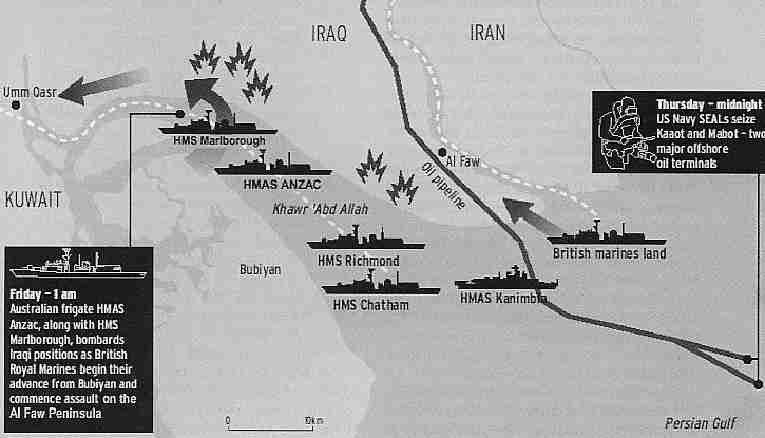- Author
- Anderson, Mark, B.Sc. (Hons), Captain, RN
- Subjects
- 21st century wars/conflict, Ship histories and stories
- Tags
-
- RAN Ships
- HMAS Kanimbla II, HMAS Darwin, HMAS Anzac III
- Publication
- September 2003 edition of the Naval Historical Review (all rights reserved)
21-22 March 2003: Naval Gunfire Support to 40 Commando on the Al Faw Peninsula.
At about 2100C we received information that NGS would not be required before 0400C. High water was at 0130C, so navigation into position was ideally undertaken just before this time. At 0300C Marlborough went to Action Stations and the Patrol Quiet State, with Mine Special Precautionary Measures in force. Chatham and Richmond were instructed to move into their respective firing positions. Marlborough and ANZAC followed and moved on into their position within the KAA channel. The transit was conducted cautiously, at 6-9kts, against a 2kt tidal stream. The minimum depth experienced under the sonar dome was for a brief period just 1.6m! Ships were all settled into station by 0430C, with communications established with the Regimental Fires co-ordinator and 148 Battery spotters on the ground.

First call for fire went to ANZAC’s 5” gun at 0604C, with further fires called from all ships in support of BRAVO Company on a military installation. Ships then fired against a bunker position in an adjacent position. Finally Marlborough, Chatham and Richmond fired against a further bunker complex in support of DELTA Company’s advance through the date palm groves south east of Al Faw town. Final engagement was at 1655C, after which 40 Commando Royal Marines (RM) halted to consolidate and await force build up before the Al Faw the following day.
Marlborough fell out from Action Stations at 1230C, as no threat was evident in the immediate vicinity and the ship had operated within its limited area for more than 8 hours. Visibility remained very poor (2nm), preventing 42 Commando insertion and limiting the availability of Tactical Air Cover. Artillery positions and missile sites had been subject to early attack and the threat was now assessed to be no greater than in the Maritime Interception Operations (MIO) areas. Three of the USS patrol boats, Firewood and Chinook and the Adak had established a patrol line 2nm to the north of our position, which provided mutual support. Adak had challenged and boarded one of two tugs moored just 3.2nm to the north of Marlborough and discovered some 40 plus mines hidden with laying rails in the body of the barge. In the afternoon, Marlborough dispatched a boarding party to assist in this investigation. By first light, visibility had improved and the flat coastline was seen 6nm to the north west. Navigation remained challenging, in a narrow channel and 2.5kts of tidal stream, with a very short period of slack water. As the wind increased to 30kts from the NW it became increasingly more testing to balance both effects while keeping 4.5” gun arcs open to the target area.
22 Mar started very sadly, with reports of a collision between two Sea King 7 helicopters from HMS Ark Royal, with seven souls on board. Marlborough responded to the first call for fire at 0843C against an observation post and gun position. ANZAC then fired against a further field gun position, as DELTA Coy continued their advance through the date palm groves toward the military installation at the tip of the Al Faw, with further supporting fire provided by Marlborough, Chatham and ANZAC. Marlborough and ANZAC were repeatedly used during this period as their positions provided better crossing fire to cover the DELTA Company advance.
The final fire mission was completed at 1556C. A total of 17 fire missions were executed with 155 rounds of 4.5” and 5” ammunition expended. Very accurate fire was provided by all systems (at near maximum ranges) with own troops in close proximity waiting to exploit effects. NGA was used to demonstrate and coerce, to encourage capitulation, with success on a number of occasions. It was employed to suppress enemy activity at short notice, to shatter confidence and to neutralise fixed protective and gun positions. Spotting corrections were extremely effective and clear. Call for Fire to first round away was typically well under two minutes in all ships, with fire available from all ships throughout the period. The Battery Commander reported ‘Success on the Al Faw was due to the aggressive use of indirect fire support, especially the swift response from NGS ships which had a huge impact on the ground and shattered the enemy’s will to fight.’




